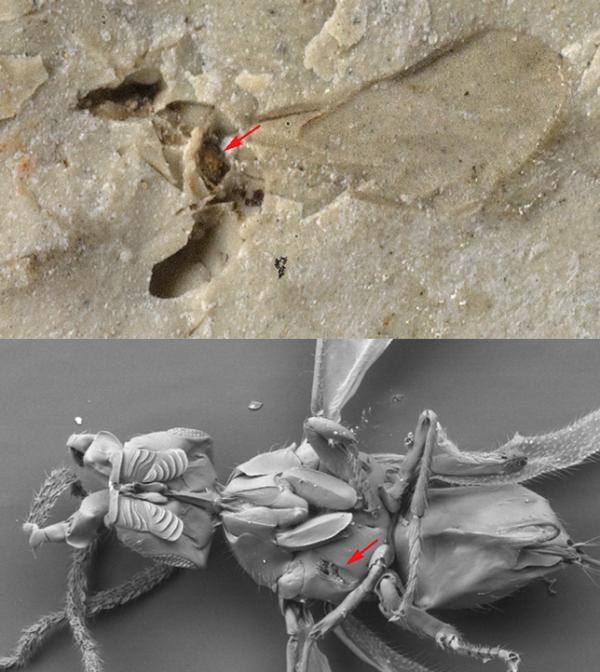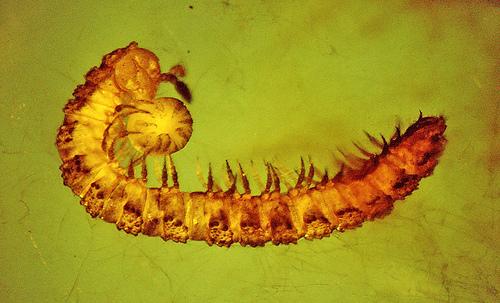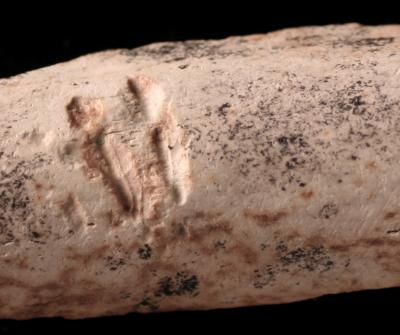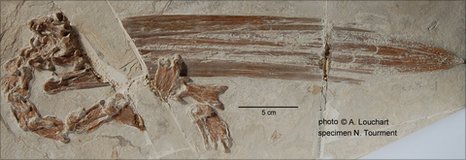Indian man, October 14, 1976, Chandigarh: Because it is extinct. We find there are those… fossilized…
Prabhupada: You do not find. This is only… You simply repeat Darwin, that’s all. You do not find. You do not see anything. You simply hear from Darwin. You have taken Darwin as your authority. But you don’t take authority, Vedas. That is your fault. Full Conversation

34-million year old fig wasp fossil which was mistaken for an ant when first described in the 1920s. The pocket where the pollen is stored has been arrowed. Bottom: Scanning electron micrograph of a modern fig wasp. The pocket where the pollen is stored has been arrowed. (Credit: Images copyright Natural History Museum, London)
World’s Oldest Fig Wasp Fossil Proves That If It Works, Don’t Change It
ScienceDaily (June 16, 2010) — The world’s oldest known example of a fig wasp has been found on the Isle of Wight. The fossil wasp is almost identical to the modern species, proving that this tiny but specialized insect has remained virtually unchanged for over 34 million years.
The fossil isn’t a new find but was wrongly identified as an ant when it was first discovered in the 1920s. Fig wasp expert at the University of Leeds, Dr. Steve Compton, was called in to study the fossil when the late Dr. Mikhail Kozlov spotted the mistake during research at the Natural History Museum, London into the flora and fauna of the Isle of Wight. The findings of Dr. Compton and the team are published in the Royal Society journal Biology Letters.
“There were three very well-preserved specimens and we were able to use modern techniques to look at them in detail,” says Dr. Compton. “What makes this fossil fascinating is not just its age, but that it is so similar to the modern species. This means that the complex relationship that exists today between the fig wasps and their host trees developed more than 34 million years ago and has remained unchanged since then.” Full Article

Millipede dying in amber clutches and curls around her newly-hatched young in a protective pose (Photo courtesy of Oregon State University)
Physorg.com: A new view of fossils – The behavior of ancient life forms
June 16, 2010: Millions of years ago a millipede dying in amber clutches and curls around her newly-hatched young in a protective pose, illustrating the types of behavior that can be studied in ancient life forms. (Photo courtesy of Oregon State University)
A new book by researchers at Oregon State University uses the snapshot-in-time miracle of amber to offer a pioneering viewpoint on all types of animal and plant fossils – not just what ancient life forms looked like, but how they functioned and behaved, especially at the moment of death. Full Article
BBC: Oldest prehistoric pelican also had big beak
June 16, 2010: Pelicans have sported big beaks for at least 30 million years, the discovery of an ancient pelican fossil reveals.
Researchers uncovered the remains of the earliest known pelican, including a preserved beak, in southwest France.
What has surprised them most about this ancient pelican is that it is almost identical to modern species.
That means that pelicans and their huge beaks have survived unchanged since the Oligocene epoch, say the scientists in the Journal of Ornithology. Full Article

This is a close-up of the tooth marks gouged in the rib bone of a large dinosaur by a mammal that lived 75 million years ago. Credit: Nicholas Longrich/Yale University
Physorg.com: Dinosaur-chewing mammals leave behind oldest known tooth marks
June 16, 2010: This is a close-up of the tooth marks gouged in the rib bone of a large dinosaur by a mammal that lived 75 million years ago. Credit: Nicholas Longrich/Yale University
Paleontologists have discovered the oldest mammalian tooth marks yet on the bones of ancient animals, including several large dinosaurs. They report their findings in a paper published online June 16 in the journal Paleontology. Full Article








Speak Your Mind